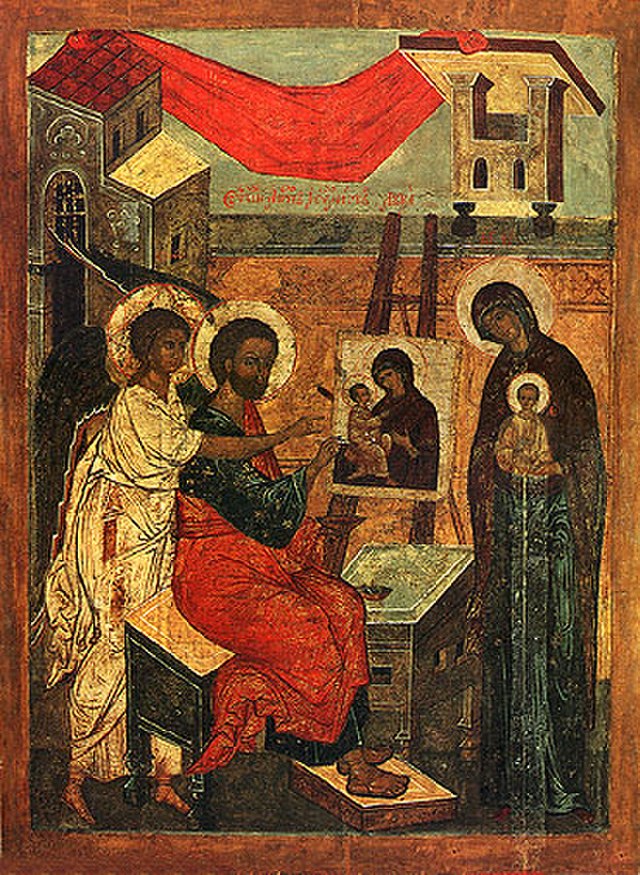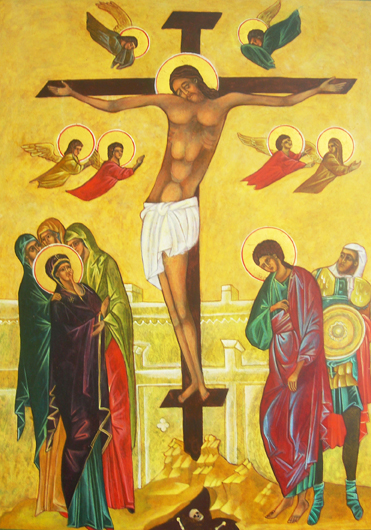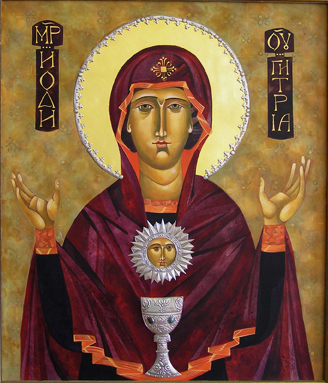The Iconography of Mary

That there are many different types and genres of Mary icons that attest to the need of all Christians to be able to relate to different aspects of her humanity and divinity at different times in their lives. Some images of Mary depict her in a time of peace, apparently apart from the drudgery and strife of our every day world, but others, like the Virgin of Tenderness and Loving Kindness, evoke the loving and kind aspects of God in ordinary life.
As the Christian Church began to split into factions with emphasis on slightly different aspects of the faith, so too, the iconography of Mary, the Mother of Jesus, has different interpretations within the denominations. To establish a common ground, I first put forth a history of Mary, both Biblical and inclusive of denominational differences when appropriate.
Mary in the Bible

The earliest New Testament account of Mary is in the Epistle to the Galatians, which was written before the Gospels. She is referred to as “a woman” and is not named: “But when the fullness of time had come, God sent his Son, born of a woman, born under the law” (Galatians 4:4).[47]
But Mary is specifically mentioned several times in the canonical Gospels and the Acts of the Apostles:
- The Gospel of Luke mentions Mary the most often, identifying her by name twelve times, all of these in the infancy narrative (Luke 1:27–2:34).[48]
- The Gospel of Matthew mentions her by name five times, four of these (1:16, 18, 20: 2:12)[49] in the infancy narrative and only once (Matthew 13:55)[50] outside the infancy narrative.
- The Gospel of Mark names her once (Mark 6:3) and mentions Jesus’ mother without naming her in Mark 3:31–32.
- The Gospel of John refers to the mother of Jesus twice, but never mentions her name. She is first seen at the wedding of Cana (John 2:1–12. The second reference has her standing near the cross of Jesus together with Mary Magdalene, and Mary of Clopas (or Cleophas), and her own sister (possibly the same as Mary of Clopas; the wording is semantically ambiguous), along with the disciple whom Jesus loved.” (John 19:25–26). John 2:1–12 is the only text in the canonical gospels in which the adult Jesus has a conversation with Mary. He does not address her as “Mother” but as “Woman”. In the Acts of the Apostles, Mary and the brothers of Jesus are mentioned in the company of the eleven apostles who are gathered in the upper room after the Ascension of Jesus (Acts 1:14).
However, most of the details we know about the early life of Mary, and the birth of Jesus taking place in a cave come from the Proevangelism of James, a non-canonical treatise of the second century.
How did canonical imagery for the Mother of God develop?

In the early formation of Mary’s iconography, there were three main aspects of her mystery, that is, her pure virginity, her fertile motherhood, and her divine sanctity that contribute to attributes and characteristics visible in depictions in her icons.
As early as the fifth century churches were being dedicated to Mary in Constantinople and the term “Theotokos”, God Bearer, Mother of God, was introduced at the Council of Ephesus in 431. After the sixth century, more and more icons of various aspects of the Blessed Mother were seen, and attributes of military power were seen as people brought icons of Mary to the battlefield for protection against invaders. Prayers relating to Mary are found as early as the Gospel of Luke.

Although there are exceptions, most of the Russian Orthodox icons of Mary can be found within four categories: Hodegitria, “the Guide, or she who shows the way”; the Eleusa, “Virgin of Tenderness, or loving kindness”; the Oranta, Our Lady of the Sign; and the Akathist “Hymn”.
Within these categories there exists many iterations named primarily after the town or village that housed them, such as in the Tenderness category there is the Kazan icon, Smolensk icon, Georgian icon,Jerusalem icon, and many more.
Hodegitria Icons of Mary have been brought to battlefields and paraded around cities for protection for centuries. They have been used to invoke military victory but she is never seen with a staff or any other sign of authority. Her icon of the Hodegetria, Mother of God, was deemed the most powerful weapon against enemies in ancient Russia.
In the Eleusa category of loving kindness, popularized in the twelfth century, The Vladimir Mother of God icon was brought from Constantinople to Vladimir by Prince Andrey Bogolubsky and was believed to protect the city from marauding Mongols.

The Orans Virgin, or sometimes called “Platytera, More Spacious Than the Heavens”, depicts Mary with her arms outstretched in the prayer position, with a young Christ in the center of her figure, and this one is based on the prophesy in Isaiah 7:14.,” Therefore the Lord himself shall give you a sign; Behold, a virgin shall conceive, and bear a son, and shall call his name Immanuel.”
The Akathist (meaning hymn) virgin, is frequently seen depicting Mary as an individual alone, without the Christ child. And without Joseph, her husband.

Most Greek churches dedicated to the Virgin Mary are called Panagia; the Most Holy; the standard western Christian designation of “St. Mary” is rarely used in the Orthodox East, as Mary is considered the holiest of all created beings and therefore of higher status than the saints.
In paintings, Mary is traditionally portrayed in blue, while in the Eastern Orthodox Marian iconography, her robe is a deep red. There are many more genres of Mary paintings in the Catholic church, variations that address particular prayer needs of the people. Examples of this are Our Lady, Untier of Knots, Our Lady of Perpetual Help, Our Lady of Gudalupe, Our lady of Sorrows, and many more.

The Christian need to believe, venerate, and pray with images of Mary is a powerful one. In a primarily patristic society, being able to relate spiritually to the most Godly of women is both a solace and source of strength. Surely the Blessed Mother demonstrated profound strength at the Crucifixion, obedience and humility at the Annunciation, and devotion to Jesus throughout His life and death, and we can draw near to her through her icons and be comforted and strengthened by her virtues and piety.
I will close with one of the oldest known prayers venerating Mary:
Beneath Thy Protection
We fly to thy protection,
O Holy Mother of God;
Do not despise our petitions in our necessities,
but deliver us always from all dangers,
O Glorious and Blessed Virgin.
Christine Simoneau Hales

Prints: https://christinehalesicons.com
Sources:
“The Dawn of Christian Art in Panel Paintings and Icons”, Thomas Mathews and Norman Muller.
Wikipedia
Wiki Common
Interesting Links For Iconographers:
From Dorothy Alexander, Iconographer in CA :
This is a link to summer internships for those studying a BA, MA, or Phd:











